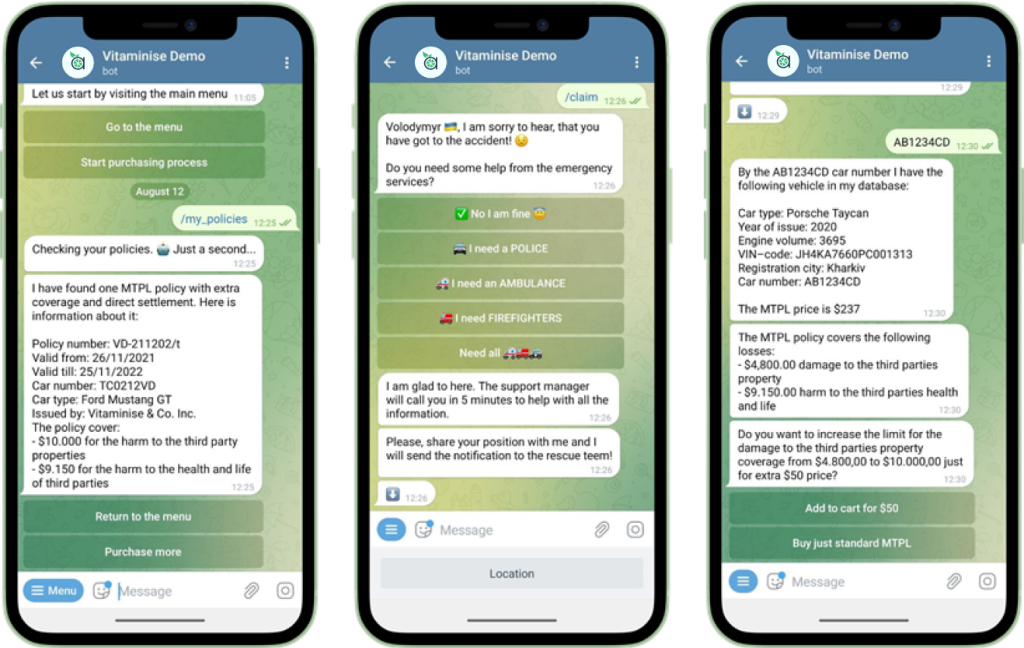

Artificial intelligence in insurance claims management
With growing customer demand for digital services, insurance companies have started thinking about how to improve various operations to provide their clients with more self-service options online. The claim management process is one of the most time-consuming, so it is no wonder that it became one of the most prioritized to be changed and innovated. Along with facing customer needs, insurers also address the following challenges while organizing claims processing: reducing costs, gaining visibility of claims activities, and modernizing legacy systems.
Optimizing the claims management process by introducing artificial intelligence (AI), deploying chatbots, and providing access to mobile apps can help insurance carriers reduce labor and administrative costs, eliminate manual work and human error, become branchless and paper-free, and increase the number of satisfied customers.
AI-powered tools in insurance claims processing
According to the Accenture study, 74% of insurance customers are dissatisfied with claim processes, often resulting in changing providers. What people really want about claims is filing those fast and from anywhere, being notified about the request status, and understanding the settlement time. All these tasks can be addressed by implementing AI in insurance claims.
AI-powered chatbots
Chatbots can guide customers in filing a claim. Unlike reporting claims through lengthy forms, chatbots allow users to do it in a few minutes or even seconds because these assistants can check whether there are already any documents in the system and autofill the necessary data. If some details are missing, the chatbot will notify the customer about that. Besides, updates can be requested by the user himself.
Another process where bots can help is claim validation. Natural language processing and machine learning patterns built into chatbots allow insurers to distinguish fraudulent claims.
Simple user requests in a chatbot can also provide information on the claim statuses. Such a user-friendly approach to claims tracking improves customer experience and increases customer loyalty.
As you see, chatbots automate claim management by eliminating manual and redundant jobs customers had to do earlier. Although artificial intelligence in insurance software is a great automation tool, it still can co-exist with human assistants, differentiating experiences various customer segments would like to get.

Learn more about our Vitaminise Chatbot for insurance companies
Document ingestion tools
As mentioned, chatbots can search for the documents that already exist in the system. This is possible because of document ingestion, which means that data has already been imported and stored in a database.
Data ingestion tools can capture various data types (claims, invoices, forms, medical records, police reports, etc.) by receiving electronic submissions or scanning physical documents. Once data is obtained, it is digitized into easy-to-perceive formats (images or PDF files), categorized, and indexed according to the predefined criteria (claim type, claimant name, date, etc.).
Overall, data ingestion systems streamline and automate claims management as policyholders don’t need to manually enter a slew of required data, and insurers, in turn, can organize and keep documents efficiently.
Image/video recognition tools
Image recognition tools, also known as computer vision systems, help computers interpret and identify visual information from images and videos: text, objects, faces, or even emotions. In claim processing, image recognition tools are used to process and capture data from documents, analyze it, and use it for further processing. Also, computer vision systems can be used for damage assessment (car accidents, property damage, etc.). They help adjusters correctly evaluate the damage and make more accurate decisions on claim settlement.
Another application of image recognition technology is fraud detection. Insurers can identify fraud by analyzing images associated with claims and find such anomalies and inconsistencies as staged accidents, altered images, or mismatched information between claims and images.
Want to optimize claim handling processes? Discover insurance claims management software development services.
Benefits of artificial intelligence in insurance
By revolutionizing claims handling with AI, insurers can compete with insurtech companies offering their customers many unique digital options. Below are the key advantages AI can bring to the table.
Benefit 1 — Improved efficiency
Thanks to decreased manual work, insurers process claims more efficiently, and claimants get reimbursements faster. That can be achieved by implementing the following:
- Automated data entry
- Fast claim intake via chatbots
- Predictive analytics to analyze historical claims and allocate resources needed
- Claim verification to determine if the claim meets the predefined criteria for approval or denial
- Fraud detection through AI-powered analysis of fraudulent activities
- Intelligent document management to process, store, and classify claim-related documents
- Personalized interaction with customers via providing relevant and timely information
Benefit 2 — Enhanced accuracy
AI technology can help improve the quality of claims processing and decision-making by contributing to the accuracy in the following ways:
- Validation of claimant information against various databases
- Risk assessment through analysis of historical claims data
- AI-powered decision-making to assist adjusters in evaluating claims
Benefit 3 — Reduced costs
By improving efficiency and automating claims processes with AI, insurance organizations can reduce expenditures for labor and resources. That can be gained through the following practices:
- Repetitive and time-consuming task automation by introducing AI for data entry, document verification, and typical customer inquiries
- Improved fraud detection made by artificial intelligence tools, which minimizes claim payouts
- Human-like interaction with customers via chatbots, which reduces customer service costs
Benefit 4 — Improved customer satisfaction
Faster claim processing time, proactive communication, and more accurate decisions facilitate better customer satisfaction and increased loyalty. So, what can be done with the help of AI?
- Data entry automation by automatic data intake from such documents as claims invoices, forms, or medical records
- Guidance of claimants by AI-powered bots and assistants without involving human agents, which speeds up the process
- 24/7 support provided through chatbots that can answer customer inquiries, provide updates on claim statuses and guide through claim-related processes
Challenges of implementing artificial intelligence in insurance claims
Although the future of insurance claims is associated with AI, insurers should consider the risks and challenges.
Data privacy
Data confidentiality is probably one of the toughest challenges of AI implementation. Consumers worry about how much personal data AI identifies, analyzes, stores, and uses without consent. So, insurance organizations should consider robust data protection measures and rules if they adopt artificial intelligence into claim management processes.
Identifying the proper use cases
To adopt AI technology, insurance carriers should first discover what areas they want to enrich with this technology. It is a daunting task as people with specialized skills and expertise are needed to correctly detect the places where AI could bring the utmost value. A thorough business analysis of claim management is recommended to identify the critical pain points claimants experience while filing claims, determine what frustrates policyholders while dealing with customer support, and discover which drawbacks claim processes have that lead to frequent fraud. Only then can insurers understand where the application of AI will be most beneficial for their business.
Integrating new technology into the current IT infrastructure
Incorporating insurance claims software with artificial intelligence into the current IT landscape is challenging as it requires special middle-layer solutions to make this integration seamless. Usually, software vendors start such complex projects with a discovery phase that includes system architecture design.
Thus, considering the latest challenge as the most complicated one, we offer you a brief step-by-step on how to implement AI in insurance industry.
Experiencing a lack of technical expertise and skills?
Connect with a professional team to address your project challenges.
Steps to integrate AI for insurance claims
DICEUS recommends using middle-layer solutions for seamless integration of AI. Here are the critical steps for that:
- Audit of the current claims management system and its modules
- Identify the challenges you would like to address with AI automation and possible use cases of AI
- Select technologies that best align with business goals and use cases of AI (machine learning, NLP, computer vision, predictive analytics, etc.)
- Develop a middle-layer architecture serving as an interface connecting databases and AI-powered tools
- Prepare data for AI analysis to ensure data quality and consistency
- Implement version control, performance optimization, scalability
- Develop APIs within the middle layer architecture to seamlessly integrate AI with current infrastructure components
- Implement security measures and consider compliance with regulations
- Conduct testing of AI tools for scalability, performance, functionality, and reliability
- Deploy the system into a production environment
By following these steps, your software vendor can successfully integrate an AI system into the current infrastructure using middle-layer solutions. If you want to employ AI in health insurance claims, for instance, or in any other business line, our team will happily help you.
FAQ
How does artificial intelligence revolutionize insurance claims processing?
Artificial intelligence in insurance sector can automate all the major processes of claim management, including document management and customer support, facilitating better efficiency, reduced costs, and increased customer engagement.
What are the key benefits of AI-driven claims processing in the insurance industry?
By adopting artificial intelligence in insurance industry for claims-related operations, carriers can decrease claim processing time significantly, which increases customer satisfaction and loyalty. Many redundant and manual tasks can be eliminated, and fraudulent activities can be identified with higher accuracy.
What role does machine intelligence play in efficient claims processing?
Machine intelligence streamlines claims processing by automating data entry, fraud detection, and decision-making, leading to faster and more accurate assessments. Additionally, it enables insurers to leverage predictive analytics for risk assessment, optimizing resource allocation and enhancing overall efficiency.
Why are data-driven insights with AI important in claims processing for insurance companies?
Insurance claims software with artificial intelligence enables predictive analytics, fraud detection, and process optimization, leading to faster and more accurate claim assessments. By leveraging vast data, AI helps insurers make informed decisions, mitigate risks, and enhance operational efficiency in handling claims.





